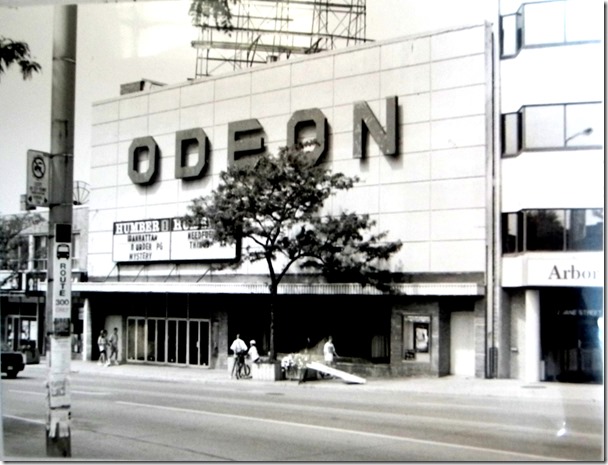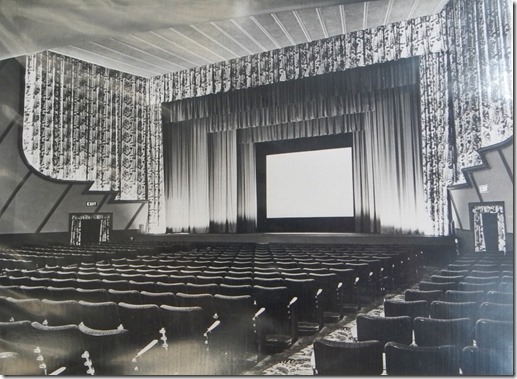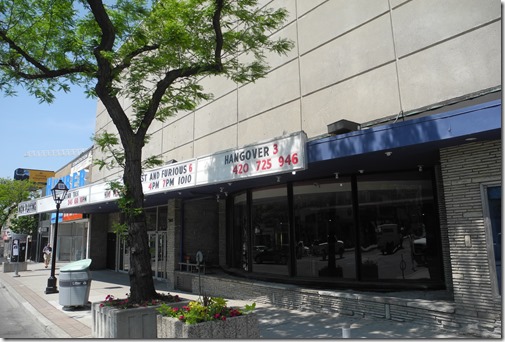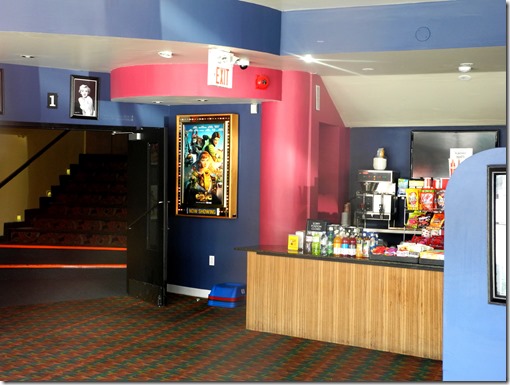The Odeon Humber Theatre in 1993, after it had been divided into two auditoriums. One of the movies on the marquee is Woody Allen’s “Manhattan Murder Mystery.” Photo City of Toronto Archives, Gilbert A. Milne 51618
The Odeon Humber was one of the local theatres that I often attended when I was a teenager. Of the five original Odeon theatres, it is the only one that remains today, all the others having been demolished.
My family relocated in 1954 from the Fairbank District, where we lived near the Rogers Road-Oakwood area. Our new home was near Jane Street and Lambton Avenue, in the west end of the city. In that year, the TTC service did not extend beyond Jane and Annette Streets, so to travel to the Humber Theatre we journeyed on the privately-owned Roseland Bus Lines to Jane and Annette Streets, and then, to reach Jane and Bloor we boarded an Annette Trolley bus.
The Humber Theatre was located in the Bloor West Village. It was only a few doors to the west of the intersection of Bloor and Jane Streets, on the north side of the street, at 2442 Bloor Street West. In the 1940s and 1950s, it was in an area that possessed much pedestrian traffic, since it where the Bloor streetcars looped before travelling east as far as Luttrell Avenue. This was prior to the opening of the Bloor /Danforth Subway in 1966.
Location of the Odeon Humber Theatre.
Designed by Jay Isadore English (1903-1947), at a cost of $400,000, the Humber Theatre opened on January 27, 1948. My first visit to the Humber was in 1954, the year that Hurricane Hazel devastated the city, causing much destruction and loss of life, when the Humber and Don Rivers flooded their banks. The Odeon Humber was a large theatre, containing 1200 seats. It was constructed by the British Odeon Chain, a subsidiary of the Rank Organization. At the beginning of Rank movies, I remember that a well-muscled man struck a huge gong at the opening of each film and the words, “J. Arthur Rank Presents” appeared on screen.
One Saturday evening, when I was in my late-teens, I attended the Odeon Theatre accompanied by a friend. After we arrived, two couples from my high school entered the theatre and sat behind us. They teased us about not having girl friends to take to the theatre on a Saturday night. Being teenagers had its embarrassing moments, which we thought were disasters.
I purchased my first car in 1967, a bright-red Acadian Pontiac, at the astronomical price of $3300. During the next few years, I often visited the Odeon Humber, parking in the Green-P parking behind the theatre, entered by the street to the west of the theatre—Riverview Gardens.
The Odeon Humber Theatre was split into two auditoriums in 1975. One theatre was on the ground floor and the other was in the space that had previously been the balcony. It received a $400,000 renovation in 1999, when larger seats, digital sound and a new concession stand were installed. It was eventually owned by Cineplex Odeon Corporation, but the company closed it in 2003. The building was empty for several years and was in danger of being demolished for condominiums. However, it was rescued by Rui Pereira, owner of the Kingsway Cinema, who reopened as a multiplex theatre named the Humber Cinemas. It now contains five auditoriums. The theatre space in the balcony remains in tact, but the ground-floor area now contains four small theatres.
It is hoped that the Humber Cinemas survives in the years ahead, as it representative of the local theatres that at one time were in almost every community across the city.
The Odeon Humbers auditorium, Ontario Archives, AO 2152
The Odeon Humber after it was converted to the Humber Cinemas, photo taken in 2013.
Entrance of the Humber Cinemas during the summer of 2013.
Lobby of the Humber Cinemas.
To view the Home Page for this blog: https://tayloronhistory.com/
To view previous blogs about movie houses of Toronto—historic and modern
Recent publication entitled “Toronto’s Theatres and the Golden Age of the Silver Screen,” by the author of this blog. The publication explores 50 of Toronto’s old theatres and contains over 80 archival photographs of the facades, marquees and interiors of the theatres. It relates anecdotes and stories of the author and others who experienced these grand old movie houses.
To place an order for this book:
Book also available in Chapter/Indigo, the Bell Lightbox Book Store and by phoning University of Toronto Press, Distribution: 416-667-7791
Theatres Included in the Book:
Chapter One – The Early Years—Nickelodeons and the First Theatres in Toronto
Theatorium (Red Mill) Theatre—Toronto’s First Movie Experience and First Permanent Movie Theatre, Auditorium (Avenue, PIckford), Colonial Theatre (the Bay), the Photodome, Revue Theatre, Picture Palace (Royal George), Big Nickel (National, Rio), Madison Theatre (Midtown, Capri, Eden, Bloor Cinema, Bloor Street Hot Docs), Theatre Without a Name (Pastime, Prince Edward, Fox)
Chapter Two – The Great Movie Palaces – The End of the Nickelodeons
Loew’s Yonge Street (Elgin/Winter Garden), Shea’s Hippodrome, The Allen (Tivoli), Pantages (Imperial, Imperial Six, Ed Mirvish), Loew’s Uptown
Chapter Three – Smaller Theatres in the pre-1920s and 1920s
Oakwood, Broadway, Carlton on Parliament Street, Victory on Yonge Street (Embassy, Astor, Showcase, Federal, New Yorker, Panasonic), Allan’s Danforth (Century, Titania, Music Hall), Parkdale, Alhambra (Baronet, Eve), St. Clair, Standard (Strand, Victory, Golden Harvest), Palace, Bedford (Park), Hudson (Mount Pleasant), Belsize (Crest, Regent), Runnymede
Chapter Four – Theatres During the 1930s, the Great Depression
Grant ,Hollywood, Oriole (Cinema, International Cinema), Eglinton, Casino, Radio City, Paramount, Scarboro, Paradise (Eve’s Paradise), State (Bloordale), Colony, Bellevue (Lux, Elektra, Lido), Kingsway, Pylon (Royal, Golden Princess), Metro
Chapter Five – Theatres in the 1940s – The Second World War and the Post-War Years
University, Odeon Fairlawn, Vaughan, Odeon Danforth, Glendale, Odeon Hyland, Nortown, Willow, Downtown, Odeon Carlton, Donlands, Biltmore, Odeon Humber, Town Cinema
Chapter Six – The 1950s Theatres
Savoy (Coronet), Westwood
Chapter Seven – Cineplex and Multi-screen Complexes
Cineplex Eaton Centre, Cineplex Odeon Varsity, Scotiabank Cineplex, Dundas Square Cineplex, The Bell Lightbox (TIFF)


![800px-Humbercinema[1] 800px-Humbercinema[1]](https://tayloronhistory.com/wp-content/uploads/2015/02/800px-humbercinema1_thumb.jpg)


![cid_E474E4F9-11FC-42C9-AAAD-1B66D852[1] cid_E474E4F9-11FC-42C9-AAAD-1B66D852[1]](https://tayloronhistory.com/wp-content/uploads/2015/02/cid_e474e4f9-11fc-42c9-aaad-1b66d8521_thumb2.jpg)

I and my twin brother, Gordon and a few of our friends were ushers in the early days of the Odeon Humber in the early 50’s. One time, during the summer, even my older brother Bill got a temporary job as an usher. In those days we sold ice cream and chips before the movie started and also at intermission. So it was amusing to attendees to see the three Jones boys assigned to each of the three rows to sell refreshments as we walked up the aisles. Owned by the British Arthur Rank organisation, the theatre was visited by a few movie stars from Britain, notably Stanley Holloway (Lavender Hill Mob). The ushers were also in charge of changing the marquee from time to time. I remember Bob Carson applying his name after “starring” to the marquee as a joke. James Mason’s “Lolita” was one the movies and we arranged to have our mom and dad see the movie, not telling them of what the subject was. My mother scolded us afterwards, embarrassed at being at the movie.